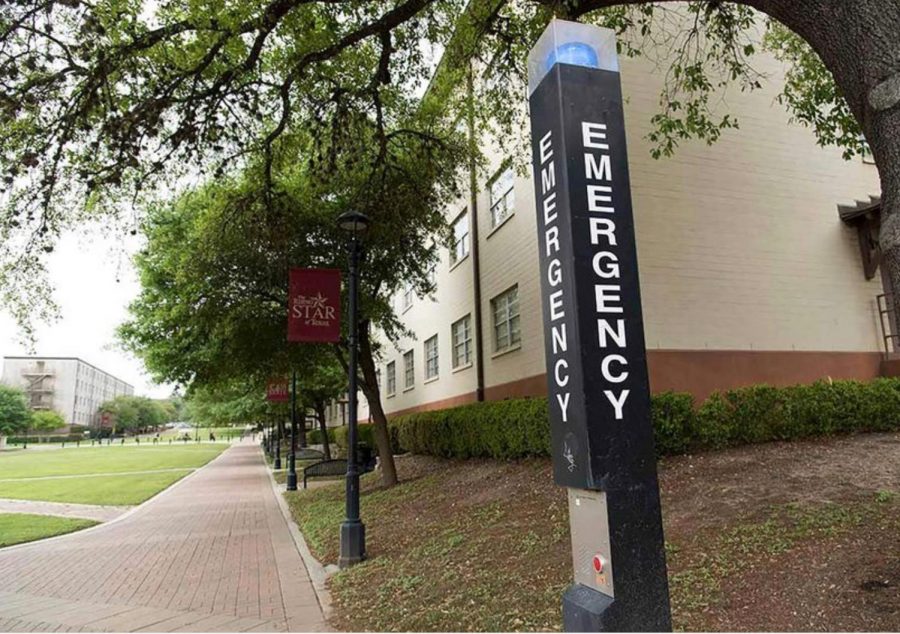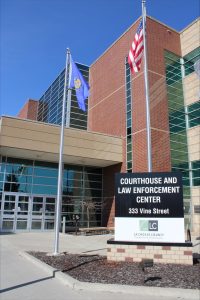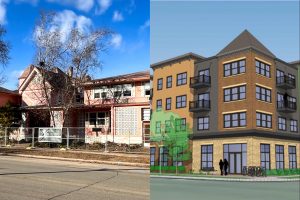Explained: The blue light towers at UWL
January 17, 2020
At the University of Wisconsin-La Crosse, there are just over 40 blue light towers placed around campus.
According to the UWL website, “If you are outside of a building, look for an emergency ‘Blue Light’ telephone. These emergency phones with blue lights on top are located around the campus and in many campus parking lots. Each box has a push button that connects directly to campus protective services via speakerphone.”
The purpose, says Allen Hill, chief of university police, is to create a platform for students to decrease the amount of opportunities perpetrators have to commit a personalized crime. “A secure environment is made possible through community involvement in crime prevention. The purpose of community crime prevention is simple: when you recognize your own vulnerability to crime, you reduce your risk through preventive action and cooperation with the police,” said Hill.
In 2014, President Obama initiated a White House task force charged with reducing rape on college campuses. In a memorandum regarding the task force, creators stated that the federal government was aware of both federal laws in place to prevent sexual assault, and their lack of effectiveness; “Reports show, however, that institutions’ compliance with these Federal laws is uneven and, in too many cases, inadequate,” wrote the office of the press secretary in the memorandum.
Rape Abuse & Incest National Network (RAINN) members wrote an advisatory proposal to the task force upon its establishment based on their own statistics and ethnography research. The task force was comprised of a population including White House, department of education, justice department, and department of health and human services representatives. However, despite this initiative, college-aged adults are still at a significantly higher risk of sexual assault.
Highlights from the letter included suggestions such as the implementation of more comprehensive campus resources, as well as arguments made for altering the connotations of sexual assault on campus:
Also among the suggestions made was the elimination of internal judicial boards. “The FBI, for purposes of its Uniform Crime Reports, has a hierarchy of crimes — a ranking of violent crimes in order of seriousness. Murder, of course, ranks first. Second is rape. It would never occur to anyone to leave the adjudication of a murder in the hands of a school’s internal judicial process. Why, then, is it not only common, but expected, for them to do so when it comes to sexual assault, as stated in the letter written bu RAINN to the White House task force.
UWL hosts a similar judicial board, headed by Chancellor Joe Gow and was recently utilized due to sexual misconduct allegations on campus.
President Obama and Vice President Joe Biden centered the task force around the subsequently created “It’s On Us” campaign, designed to encourage problem identification, effective prevention and law enforcement transparency. Nowhere in the task force’s agenda was there a mention of increasing the accountability of students on campuses who are at risk of becoming victims.
In his statement to The Racquet Press, Hill touched on the significance of the blue towers on campus to the ability students have to prevent crime via one aspect of what is known as the crime triangle. “The lifeblood of criminal activity contains three elements, commonly called the ‘Crime Triangle.’ Means, Motive, and Opportunity make up the crime triangle, and opportunity is the only element that we can prevent. The UWL Police Department encourages everyone to take an interest in their own personal safety by preventing opportunities for a crime to occur.”
In this way, the blue light towers become a method for students to assume responsibility for their part in violent crime.
University statistics organization, “College at All Costs,” compiled information regarding the blue light towers in universities across Georgia, using Clery Act Statistics. “Based on the data collected, there was no conclusive statistical evidence that showed blue light phones made any difference in lessening these crimes. Each crime was looked at individually, taking into account enrollment numbers and campus sizes, but no discernable trend was found,” said campus safety investigators Zach Hansen and Anna Logan.
According to Hill, the towers see a similar lack of intended use at UWL. “Most calls that we receive are accidental or someone asking for general information, I don’t know the last time an actual emergency call came from a blue light phone,” said Hill.
This does not mean that crime does not occur on the UWL campus. “I get about 100-125 referrals [reports of sexual misconduct] a year, is the standard. That includes not only sexual violence but domestic violence or dating violence, stalking… things of that nature. Something like one in four, might even be more like one in three women experience domestic violence in their lives. And we certainly see that on campus as well,” said violence prevention specialist Ingrid Peterson, in a former interview with The Racquet Press.
The towers are not without expenses. Based on estimations made by Code Blue and Rath Security, midwest-based security organizations, universities can expect to spend between 1,500 dollars and 10,000 dollars on the blue light towers, depending on the amenities of the specific tower model. This creates a purchase and maintenance fee that is attributed to student tuition.
Hill included in his statement that the blue light towers at UWL do not come equipped with video surveillance, making their capabilities similar to that of a cell phone.
According to RAINN statistics, in the United States, 39 percent of rapes are committed by an acquaintance, and 33 percent of rapes are committed by a former spouse or romantic partner. Aggravated assault, the category that encompasses rape, is the most common crime against the person on college campuses. These statistics create a disconnect from the blue light towers, as statistically, most rapes don’t happen in the open areas on campus where the towers are located.
Campaigns and organizations such as “It’s On Us” and RAINN emphasize the importance of law enforcement and school officials to maintain an air of delicacy and efficiency when approaching sexual violence and personalized crime. They believe in the efficacy of a collective population to prevent violence. “The mission of ‘It’s On Us’ is to combat college sexual assault by engaging young men and changing campus culture.”
For more information about “It’s On Us”, or to take the pledge, visit: https://www.itsonus.org/pledge/
For easy access to university police during emergency situations or otherwise, contact (608) 789-9000. Hill encourages students to reach out if they see behavior they find suspicious or unusual.







